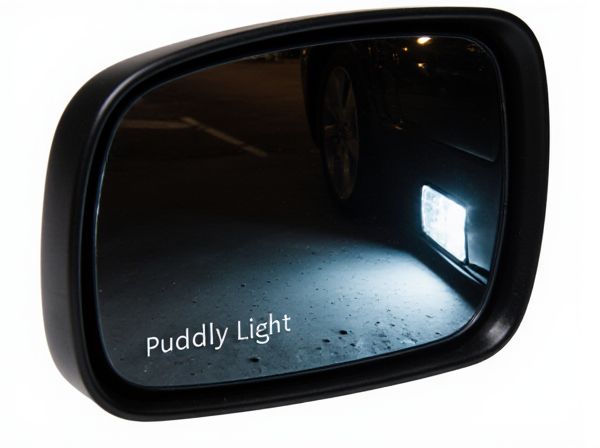
Photo illustration: Puddle Light vs Non-Puddle
Puddle lights enhance safety by illuminating the ground around your vehicle, helping you avoid puddles, uneven surfaces, or obstacles in low-light conditions. Non-puddle lighting, such as standard door or overhead lights, provides general visibility but lacks focused illumination on the ground. Choosing puddle lights improves your entry and exit experience by ensuring your path is clearly visible.
Table of Comparison
| Feature | Puddle Light | Non-Puddle Light |
|---|---|---|
| Function | Illuminates ground near the car door for safety and visibility | No ground illumination; standard mirror lighting only |
| Safety | Reduces risk of stepping into puddles or obstacles | No additional safety lighting provided |
| Convenience | Eases entry/exit in dark or wet conditions | No enhanced convenience features |
| Energy Consumption | Uses extra LED power for illumination | Lower power usage, no extra lights |
| Cost | Typically higher due to added lighting components | Generally more affordable |
| Appearance | Adds a premium, modern look to side mirrors | Standard mirror design |
Introduction to Puddle Lights vs Non-Puddle Lights
Puddle lights are small, low-intensity LED lamps installed near a vehicle's doors, designed to illuminate the ground directly beneath the door area, enhancing safety and visibility when entering or exiting. Non-puddle lights refer to standard exterior lights like headlights, taillights, and interior courtesy lights that serve broader illumination purposes but do not specifically target the ground near door thresholds. The primary distinction lies in puddle lights providing localized, ground-level lighting that reduces the risk of stepping into puddles or uneven surfaces, unlike general vehicle lights.
What Are Puddle Lights?
Puddle lights are small LED lights mounted under a vehicle's side mirrors or doors designed to illuminate the ground when entering or exiting the car, enhancing safety by preventing slips and trips in dark conditions. Unlike non-puddle lights, which may only provide ambient or interior lighting, puddle lights specifically target the immediate area around the door, improving visibility of obstacles or puddles. These lights contribute to both safety and vehicle aesthetics, often activating automatically when the car is unlocked or the door is opened.
Key Differences Between Puddle and Non-Puddle Lights
Puddle lights are designed to illuminate the ground near vehicle doors, enhancing safety and visibility by reducing the risk of stepping into puddles or obstacles. Non-puddle lights serve general illumination purposes, often positioned on the vehicle's exterior for aesthetic or functional lighting without targeting the immediate ground area. The key difference lies in puddle lights' specific focus on ground illumination versus the broader, more varied applications of non-puddle lights.
Benefits of Puddle Lights
Puddle lights enhance vehicle safety by illuminating the ground near the doors, reducing the risk of stepping into hazards like puddles, uneven surfaces, or debris in low-light conditions. These lights improve visibility for passengers and drivers, facilitating safer entry and exit, while also adding a sleek, modern aesthetic to automotive design. Compared to non-puddle lighting, they contribute to increased convenience and protection, especially in dark or wet environments.
Advantages of Non-Puddle Lights
Non-puddle lights offer the advantage of broader illumination, enhancing visibility around vehicle doors without limiting light projection to a confined area. These lights improve overall safety by evenly lighting larger sections of pavement or surroundings, reducing trip hazards and increasing awareness of obstacles. Their wider light distribution also contributes to better aesthetics and functionality for drivers entering or exiting vehicles in dark environments.
Installation and Compatibility
Puddle lights typically require a dedicated power source and specific mounting points, making installation more complex compared to non-puddle lights, which often use simpler plug-and-play designs compatible with various vehicle models. Compatibility varies as puddle lights are usually designed to fit specific car makes and models, whereas non-puddle lights have broader compatibility due to their standardized sizes and connectors. Understanding vehicle wiring and mounting options is crucial for seamless integration of puddle lights, while non-puddle lights are preferable for quick upgrades without extensive modifications.
Aesthetic and Functional Impact
Puddle lights enhance vehicle aesthetics by providing a sleek, modern glow around the door area, improving curb appeal and nighttime visibility. Functionally, puddle lights illuminate the ground beneath the door, reducing the risk of stepping into puddles or uneven terrain, while non-puddle lighting lacks this targeted illumination and offers limited practical benefit. The integration of puddle lights combines stylish design with increased safety, creating a superior user experience compared to standard door lighting.
Cost Comparison
Puddle lights typically incur higher initial costs than non-puddle lights due to their advanced LED technology and design features that enhance vehicle safety by illuminating the ground near doors. Non-puddle lights usually have lower installation and manufacturing expenses, making them a budget-friendly option without specialized ground lighting. When comparing total expenses, puddle lights may involve greater upfront investment but can add value through improved visibility and aesthetic appeal, while non-puddle lights remain cost-efficient for basic lighting needs.
Popular Car Models with Puddle or Non-Puddle Options
Popular car models like the Toyota Camry and Honda CR-V offer puddle lights, enhancing visibility and safety by illuminating the ground near the vehicle's doors. Conversely, models such as the Ford F-150 and Hyundai Elantra may provide non-puddle light options, focusing on basic entry lighting without ground illumination. Consumers often choose puddle light-equipped vehicles for added convenience and luxury features, especially in higher trims of SUVs and sedans.
Which Option Is Right for You?
Choosing between puddle lights and non-puddle lights depends on your vehicle's needs and personal preferences. Puddle lights provide enhanced visibility and safety by illuminating the ground near your car doors, ideal for dark or uneven parking areas, while non-puddle lights offer basic illumination without extra coverage. Consider your driving environment and safety priorities to determine which lighting option aligns best with your lifestyle.
 caratoz.com
caratoz.com